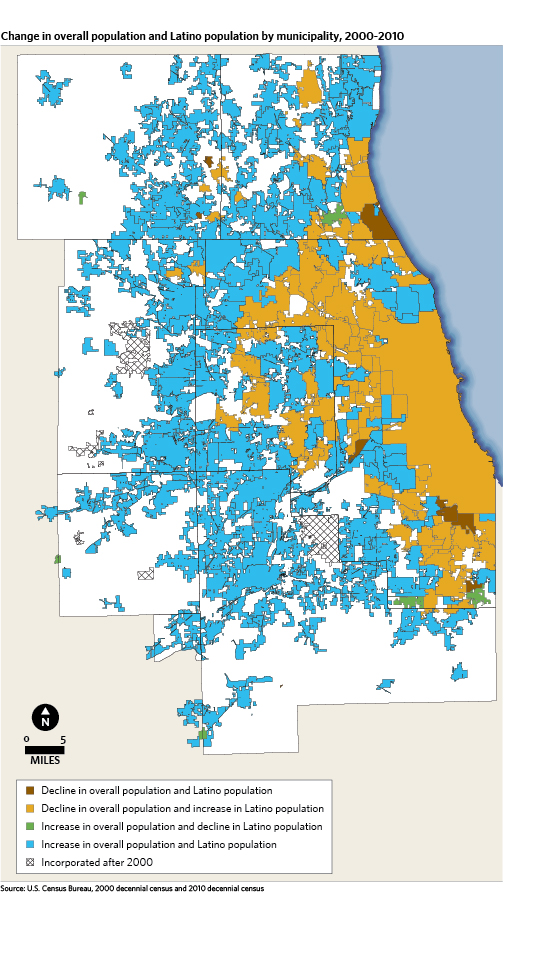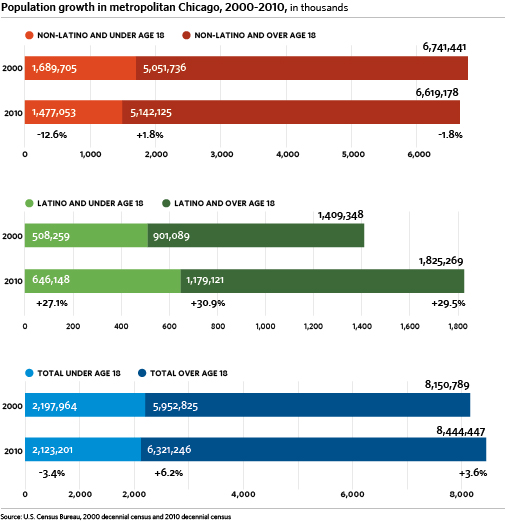Among the most significant aspects of Illinois population data released from the 2010 decennial census is the growing number of Latino residents in northeastern Illinois, the primary contributor to our region's population growth over the past ten years. This has many implications for regional planning. CMAP's Regional Snapshot, Latinos in Our Region, describes how Latino population growth could affect components of comprehensive planning, including employment, income, and education; land use, transportation, and housing; and quality of life issues such as health, recreation, and civic involvement.
Latinos will make up more than 30 percent of the region's population by 2040, according to GO TO 2040. Further analysis of recently released 2010 decennial census data indicates that 21.6 percent of the region's residents were Latino in 2010, up from 17.3 percent in 2000. Latino residents represent a larger proportion of the population in 2010 because Latino population growth has outpaced growth in the overall population. The Chicago metropolitan area grew from 8.2 million to 8.4 million residents between 2000 and 2010, a 3.6 percent increase. During the past decade, the Latino population grew from 1.4 million to 1.8 million residents, a 29.5 percent increase. The growth in Latino residents was actually greater than the region's overall population growth by 122,263 residents. In other words, a reduction of 122,263 non-Latino residents was offset by an equal increase in Latino residents.
As expected from prior American Community Survey population estimates, communities in outlying areas of the region experienced most of the population growth over the past decade, while Chicago and many of its nearer suburbs experienced population decline. At the same time, growth in the Latino population occurred in all but 15 of the 284 municipalities in the region between 2000 and 2010. The following map provides an overview of population changes in the northeastern Illinois between 2000 and 2010.

Of the 180 municipalities in the region that experienced population growth, all but six experienced an increase in Latino residents. In the 174 municipalities experiencing both overall growth and growth in the Latino population, the growth in the Latino population accounted for 51.6 percent of the total overall growth. At the same time, 70.2 percent of the total Latino population growth in the region occurred in these growing municipalities.
Of the 98 municipalities to experience population decline in the region, 89 of them saw growth in the Latino population. Latino population growth in these shrinking municipalities accounted for 23 percent of the total growth in the Latino population. (About 6.8 percent of the growth in the Latino population occurred in unincorporated areas, which are not shown on the map).
The census data does not provide very much insight as to why the region's Latino population is growing at a faster rate than the non-Latino population. According to a recent Brookings Institute report, most Latino population growth in the U.S. is due to births rather than immigration from foreign countries. The census does provide a sign that some of the differential growth may be the result of birth rates. Between 2000 and 2010, northeastern Illinois population aged under 18 declined by 3.4 percent, while the region's Latino population under age 18 grew by 27.1 percent. However, it remains unclear whether Latino population growth in metropolitan Chicago is driven more by births, relocation from other regions, or immigration.

GO TO 2040 predicts that metropolitan Chicago will continue to experience significant demographic changes in part due to rapid growth in the region's Latino population. For a variety of reasons, it is important for regional planning to consider this growing segment of the population. According to CMAP's Latinos in Our Region snapshot, college completion rates among Latinos in the region are lower than the rates of non-Latinos. Differences in educational attainment are important because of the link between levels of education and earnings. The snapshot report also found that the earnings gap between Latinos and non-Latino whites increased between 2000 and 2006. As our economy continues to shift toward knowledge-based jobs, a skilled and educated workforce will be critical to our region's economic success. Increasing education levels among the fastest-growing segment of the region's population will be necessary for the regional as a whole to remain strong.